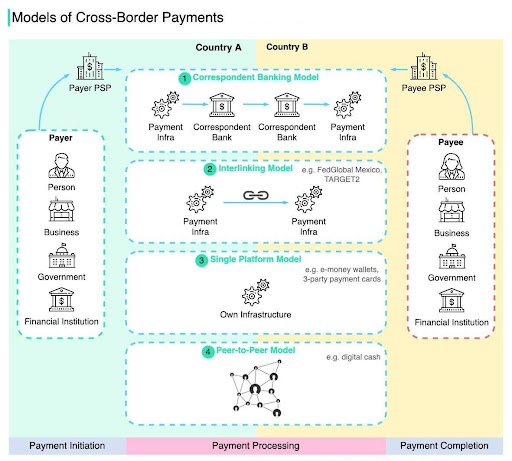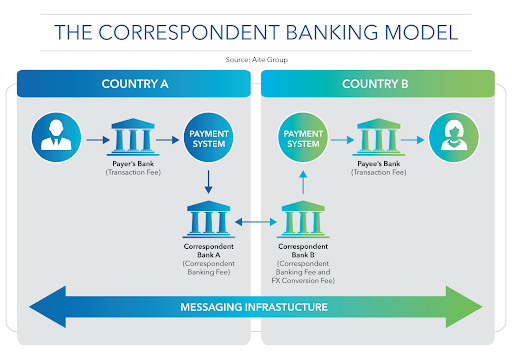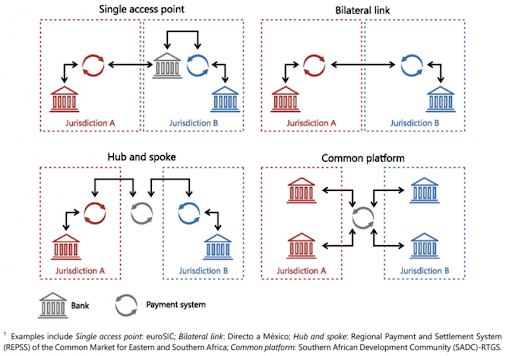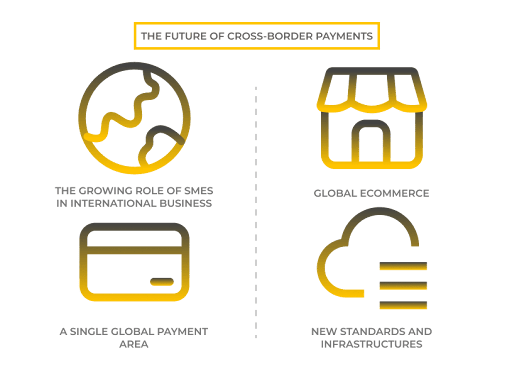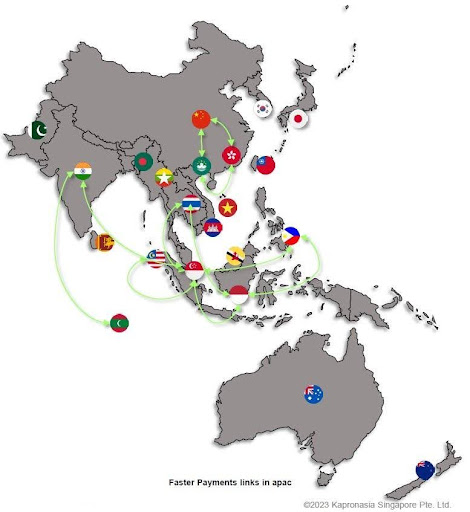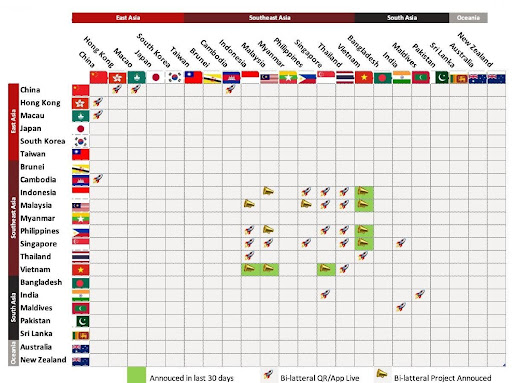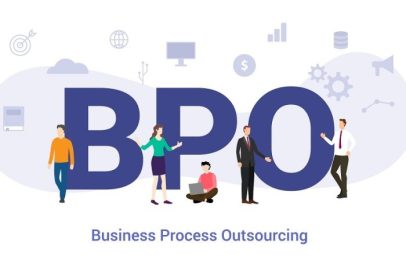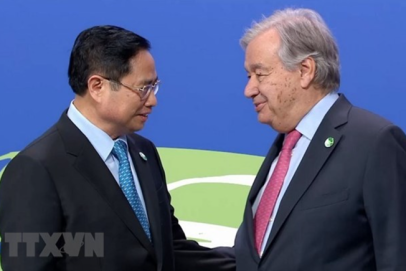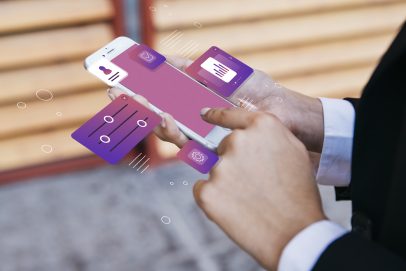Cross-Border Payments and things you need to know
The digital era is forming a transformation in cross-border payments, changing the way global transactions are conducted and shaping the future landscape of the financial market. Therefore, organizations and globally operating enterprises need to grasp new trends to seize opportunities and overcome challenges.
1. What is Cross-Border Payments?
Cross-border payments, also known as international payments, are financial transactions where the sender and recipient are located in different countries. They are an essential part of the global economy, facilitating international trade, tourism, personal remittances, and various other activities.
The Internet and the transfer to online businesses contributed to the rapid growth of world trade over the years. Therefore, most financial institutions and payment systems have developed cross-border payments to facilitate and speed up money transactions.
Causes driving cross-border payments:
- The rise of e-commerce: The global explosion of e-commerce has spurred demand for more efficient and secure cross-border payment solutions. Consumers increasingly shop from international markets, prompting retailers to provide diverse and convenient payment options.
- Payment technology advancements: New technologies such as blockchain and digital currencies have opened up new opportunities for cross-border payments. Blockchain-based solutions like Ripple or emerging stablecoins are being explored as means to reduce costs, waiting times, and enhance transparency in international transactions.
- Global regulation and cooperation: Regulatory bodies worldwide are collaborating to establish a legal framework for cross-border payments, aiming to protect consumers and prevent money laundering and terrorist financing. An example is the Society for Worldwide Interbank Financial Telecommunication’s (SWIFT) Global Payment Innovation Initiative (GPI), aimed at improving the speed, transparency, and tracking of cross-border payments.
- Rise of international payment platforms: Companies like PayPal, Wise (formerly TransferWise), and Revolut are expanding their services to include cross-border payment options, offering faster and less costly methods for international money transfers.
2. Models of Cross-Border Payments
- Correspondent banking model
Correspondent banking remains the most prevalent cross-border payment arrangement. Transactions can involve multiple hops through intermediaries, which can increase fees and delay availability of funds. This arrangement relies upon banks holding deposits owned by other respondent banks in order to provide payments and services on behalf of respondent banks.
The correspondent bank holds deposits owned by other banks from other countries. This allows banks to access financial services in different jurisdictions.
Under some international card schemes (Visa, Mastercard), participating banks typically rely on correspondent banking for settlement.
- Interlinking model
This enables PSPs (Payment Service Providers) participating in the payment infrastructure of one country to send and receive payments to/from PSPs participating in another country’s infrastructure.
Interlinking can be costly and complex from a legal, operational and technical point of view, and therefore has generally only been set up between countries with considerable economic activity between them and/or migration flows.
Interlinking arrangements for cross-border payments can be defined as a set of contractual agreements, technical links and standards, and operational components between payment systems of different jurisdictions, allowing their respective participating PSPs to transact with one another as if they were in the same system. An interlinking arrangement enables a PSP participating in the payment system of country A to send payments to PSPs participating in the payment system of country B without the need for country A’s PSP to open accounts in country B or become a participant in country B’s payment system. Interlinking arrangements can be a series of bilateral links each with their own rules or links under a common framework.
Below is stylised models for interlinking cross-border payment systems
Single access point model
Under a single access point model, participants in one (domestic) payment system have access to a foreign system through a single “gateway” entity that directly participates in the foreign system (upper left-hand panel).9 This model bears a resemblance to correspondent banking arrangements but differs in that it ensures access to the foreign systems based on common rules, service level agreements (SLAs) and access criteria. Despite simplicity and low cost, the single access point has scalability limitations.
One example of this model is euroSIC. Introduced in 1999, this system processes euro payments to, from and within Switzerland. euroSIC runs on the same technical platform as the domestic RTGS system for Swiss francs (SIC). Both systems are owned and operated by Swiss Infrastructure and Exchange (SIX), a private financial services company. Cross-border euro payments are channelled through Swiss Euro Clearing Bank (SECB), a subsidiary of SIX. SECB is a licensed bank in Germany and a participant in TARGET2. It acts as a single gateway entity for euroSIC members to all euro area jurisdictions through TARGET2.10 Another example is the Hong Kong’s RMB CHATS links with Mainland China’s payment systems.
Bilateral link model
Two payment systems can also be directly connected to each other (upper right-hand panel). This model typically enables participants in one system to directly reach all direct participants in the other (foreign) payment system instead of just the single gateway entity. Among other things, a bilateral link requires efficient mechanisms for accounting, clearing and settling inter-system positions between interlinked systems, and this process is usually done through nostro/vostro accounts that linked systems hold with each other. Establishing a bilateral link can be relatively cost-effective and serve as an interim step towards a more centralised approach. However, a multitude of bilateral links results in complex processes, as multiple interoperability arrangements must be maintained.
An example of a bilateral link model is Directo a México, which was set up in 2005 between the United States and Mexico and links the Federal Reserve’s automated clearing house (FedACH) with the Mexican RTGS system (SPEI). Another example is the link between India (UPI) and Singapore (PayNow).
Hub and spoke model
A hub and spoke model is a multilateral interlinking arrangement capable of linking more than two systems (lower left-hand panel). In this model, the inter-system accounting and clearing are done at a common intermediary (the hub). In some jurisdictions, the hub itself could be qualified as a multilateral payment system, with the connected payment systems as participants. The hub can effect settlement on its own books or use a settlement agent. While it is assumed that the (domestic) payment systems connected to the hub are bound by the hub’s rules, this is not necessarily the case for PSPs connected via a (domestic) payment system to the hub. The hub and spoke model is scalable, since with one connection to the hub a payment system can reach all other connected (foreign) systems.
An example of this model is the Regional Payment and Settlement System (REPSS) of the Common Market for Eastern and Southern Africa. REPSS has a common clearing house in the middle and the Central Bank of Mauritius acts as a common settlement agent, which debits and credits the accounts of the participating central banks on its books.
Common platform model
In a common platform model, PSPs from one jurisdiction can directly reach PSPs in other jurisdictions through one common payment system, which runs on a single integrated technical platform. While the common platform model can lead to the same results as interlinking, it is in a strict sense not interlinking since PSPs are participating in one and the same payment system.
As a common platform requires the harmonisation of many attributes, it is technically the most complex model, since it requires a fully fledged payment system to be set up (lower right-hand panel). SADC-RTGS is an example of this model. This system is hosted by the South African Reserve Bank (SARB) and runs on the same infrastructure as the SARB’s domestic RTGS system (SAMOS). The system currently settles payments only in ZAR and its participants (ie banks from different SADC jurisdictions) have ZAR accounts directly in the SADC-RTGS.
- Single Platform Model
PSP of the payer is the same entity (or part of the same group) as the PSP of the payee. This can be the case for proprietary arrangements (e.g. traditional money transfer operators), some international card schemes (i.e. “3-party model”) and e-money schemes, or multinational banks that are present in the payer’s and the payee’s country.
- Peer to Peer Model
The peer-to-peer model cuts out the financial intermediary PSP and enables the payer to send the payment directly to the payee. For example, sending crypto assets over blockchains falls into this category.
3. Benefits from Cross Border Payments
The modern world economy is characterized by positive trends such as globalization and growing population mobility. All of this contributes to the continuous growth of the need for cross-border payments. Therefore, among the main advantages of cross-border payments and settlements are the following:
- Minimization of fees
People used to the fact that most of the cross-border transactions usually involve huge fees. Bank transfers to other countries most often include commissions from both the sender and the recipient.
Not only does it take longer, but it also costs more because there are more participants involved (the local bank, the foreign bank, and the bank transfer systems of both banks).
Now, with the use of modern fintech technologies, users can take advantage of the cross-border transaction process. In comparison to the traditional banks, the use of modern cross-border payment systems is usually significantly cheaper or sometimes can be free of charge.
- Hidden fees in the exchange rates
The foreign payment system offers fixed rates for sending money. With fixed exchange rates, the value of a country’s currency is specified with the value of another country’s currency. In fact, this should guarantee the stability of the exchange rate and exclude sharp currency fluctuations.
- The broader global coverage
Moving funds has become more accessible, enabling broader ensured payment coverage in hundreds of countries. The ease of the process includes:
- Faster and simpler payment channel;
- The process takes only a few minutes instead of a few days;
- Ease of access allows individuals and legal entities to move funds anywhere and anytime, using only a device connected to the Internet.
4. Cross-Border Payments Regulations
Each country has its own set of laws, regulations, and reporting requirements that govern cross-border payments. As a result, the more payments from different countries you accept, the more complex the legal requirements become. For example, some countries, such as China and India, tightly control the money leaving their border.
Another critical point is the purpose of the payment and the amount of money the sender would like to transfer. It can be necessary to provide particular regulatory or banking forms to make a payment.
International standards are determined by EU directives and other regulations governing cross-border payments regulations, which address:
- Issues of banking law coordination;
- Pervices for conducting payment transactions;
- Protecting the interests of participants in cross-border payments systems;
- Functional characteristics and safety of settlement funds;
- Creation of legal protection for participants and clients of cross-border payments systems;
- Standard European norms for cross-border payments transfers;
- Legal standards of final mutual settlements in payment systems;
- Acceleration of cross-border payments transfers;
- Improving the transparency of payment turnover for clients;
- Equality while paying for cross-border payments transactions with the same transactions within the country;
- Rules for cross-border payments securities;
- International agreements governing the regulations of bills and check circulation.
The EU created a Single Euro Payment Area (SEPA) to simplify payments between their member states. An example of EU Regulation for cross-border payments is the Regulation (EC) No 924/2009 that was accepted in the context of the Single Euro Payments Area (SEPA). It asks banks to apply the exact charges for domestic and cross-border electronic payment transactions in euro.
The new laws detailed under PSD2 (Payment Services Directive) will work for the cross-border payments made within the EU. If at least one part of the payment journey is outside of the EU, the cardholder will not have to experience the two-factor authentication process. But the rule will apply for customers making cross-border payments from one EU Member State to another. It ensures a secure transfer and created a single digital market.
5. Trends Reshaping Cross Border Payments
The constant changes of the cross-border payments process lead to new business models and new trends that modify the world transactions volume. The trends we now can predict are:
- Consumer demands are changing rapidly
The banking services are expected to become more flexible and fast, while the consumers are less likely to pay for additional banking services. The developing era of smartphones and quick alternative payment methods (APMs) raised the demand for cross-border payments quality to a new level. The new providers come with new cross-border payments solutions and offer cheaper and more transparent advantages than the banks.
- Trade with emerging markets
Another increasing trend of cross-border payments is the switching focus on new international markets in Latin America, Africa, and Asia. There is a prediction of increasing cross-border trade by 5% (CAGR) until 2022 from global markets powered by initiatives like the African Continental Free Trade Area and China’s Belt and Road Initiative. While in western markets, there is a slight growth of around 2% (CAGR) caused by the changing political situations, including Brexit and US trade tensions.
- More world access to the mobile phones and e-payments
With the rise of phone accessibility and switch to the remote way of life, more customers discovered that e-payment solutions could bring more benefits and save their time. In 2021, the number of smartphone users worldwide raised to 3.8 Billion, which means 48.20% of the world’s population. This figure is predicted to increase every year. Overall, the global wallet at the POS (point-of-sale) is expected to increase to 52% in 2023. All this will lead to the development and more accessibility of cross-border commerce volumes.
- A wide range of electronic payment providers
All over the world, there is increased popularity and demand for electronic payments. Many electronic payment providers currently maintain services for storing, money exchanging, money transferring, and payments. Each provider has its own strong and weak points, so there is no definite answer to the question of which one should be entrusted with your funds.
6. Fintech and Cross Border Payments
The global trend of Fintech development at the moment is digitalization, automation, and informatization. These are pillars of modern development programs in many countries. Cross-border payments are no exception. Solving the problems of transferring operations often depends on the implementation of blockchain technologies, big data, and many other innovative systems.
New alternatives for fintech settlements improve the overall efficiency of cross-border payments. These include:
- Interconnections between internal payment infrastructures;
- The expansion of closed systems across borders;
- Blockchain-based peer-to-peer payment solutions, also known as Distributed Ledger Technology (DLT);
- CCPS (Cross-Carrier Payment Systems) work in mobile operators’ networks and conducts cash transactions in real-time.
The payment system in the blockchain systems uses Rich Communications Services (RCS) protocol, an advanced SMS simulator that can transmit multimedia data and perform service discovery. Thanks to the presence of RCS, customers will be able to use applications on their mobile devices for cross-border payments and don’t need to change the currency at the bank.
The companies are also developing systems for transferring funds using mobile networks. However, such payment systems are just the beginning of distributing blockchain solutions for the communications sector. They also plan to deal with another important aspect of financial transactions – security issues. It requires the development of concepts of identification and client authentication.
7. The Future of Cross Border Payments and A new paradigm
International payments have long been a power enabling cross-border trade and investment in today’s global economy. The banks deserved the reputation of cross-border market owners, while the great list of requirements such as regulations and technical infrastructure has prevented international trade from developing fast.
Today, the demand for cross-border payments is so high that we can observe a new paradigm of changes that lead to the general improvements of the whole cross-border payments landscape. Here are some of the most brilliant examples of the future cross-border direction.
The growing role of SMEs in international business
The SMEs (Small and Medium Enterprises) have started to benefit more from the simplification of cross-border payments, as they have more access to affordable solutions, giving more flexibility in their options (like SWIFT or Mastercard). The traditional banks are no longer able to fulfill this fast access to international payments.
Global eCommerce
With the development of e-commerce, there is an increase in the number of payment systems. They become faster, which leads to a decrease in cash transactions in the world. As businesses and consumers have grown accustomed to faster, cheaper, and more convenient payments, customers’ expectations are higher. It has helped drive innovation in interface systems that improve the user experience with mobile technology, e-wallets, and e-commerce.
A Single Global Payment Area
The example of a Single European Payment Area (SEPA) shows the considerable benefits for the European trade, bringing more transparency, security, liability, efficiency, and quality customer services. Open banking is becoming a standard that customers are getting used to.
New standards and infrastructures
Modern, open, and globally implemented standards are crucial to ensuring an instant and easy cross-border payments comparable to internal payments. The transition of payment systems in Europe, the USA, and the UK to the open standard ISO 20022 in November 2021 will push the development of integration both within and between countries.
The use of this standard will allow banks to make instant cross-border and domestic payments directly to the accounts of final recipients. It will enable the markets with the lower turnover to develop faster and reach the international level. And for larger markets, it will create conditions for making payments across the entire set of currencies in real-time within the market between banks, various payment service providers, card schemes, a gross settlement system, and local clearinghouses. Moreover, this standard will create long-term prerequisites for the introduction of new technologies in the financial industry.
8. Summary Asia-Pacific Cross Border Payments
- SWIFT largest network with over 785 Banks across APAC live on GPI
- Significant progress of cross-border enablement for retail through central banks, driven bi-lateral arrangements across the region
- 12 faster payments systems linked for cross border as of August 2023.
- SE Asia most active with Philippines/Malaysia, Indonesia/Philippines announced recently for QR and In app use cases
- Over 20 existing or potential multilateral wholesale platforms, most of which are regional systems
- Several wholesale projects moving from pilots into live phases
APAC bi-latteralpartnerships growing strong, however some key mature markets falling behind, with emerging market central banks leading the charge.
Low adoption remains a concern, high-cost implementation yet to find adoption and deliver volumes.
Vietnam announced in August it will connect to a number ofneighboring South-east Asian markets including Singapore, Philippines, Indonesia and Malaysia
Some of the largest economies –Japan, Korea, Taiwan, Australia, New Zealand sill lag behindon interop projects, with governments increasing pressure on central banks to start programs.
9. Vietnam’s Cross-Border Payments
Vietnam’s central bank has signed an MoU to develop its cross-border payments service system together with five other ASEAN member countries.
Vietnam is striving to improve its regional payment connectivity and facilitate the development of more transparent, affordable, trackable, and faster cross-border transactions. This has seen the emerging Southeast Asian nation sign on to an MoU with other ASEAN states to work together on a mutually beneficial cross-border payments system.
Some statistics
In 2021, there were nearly 24.7 million mobile wallet users in Vietnam, according to Statista. That number is expected to increase almost threefold by 2026, reaching around 67.6 million users.
In this vein, a Decision Lab survey in 2021, found that in over three months, 70 percent of respondents said they had used internet banking to make a payment, followed by cash (63 percent of the respondents), and 61 percent had used an ATM card or made a bank transfer.
As per Robocash research, the Vietnamese FinTech market is anticipated to reach US$18 billion by 2024. This presents a significant shift in Vietnam’s financial services sector, where faster and cheaper payment innovations are overtaking traditional payment methods.
And now Vietnamese consumers and businesses are demanding a more robust payment infrastructure to facilitate cross-border transactions that can support payments in multiple currencies.
What’s in the MoU on cross-border payments?
Under the MoU, the Vietnamese government has committed to developing cross-border payment connectivity for retail transactions, including quick response (QR) codes, instant payments, and other emerging payment models.
Vietnam’s participation in this agreement will help the country to launch cross-border payment systems, which will contribute to the development of regional trade, investment, tourism, e-commerce, and many other economic sectors.
Policy and regulations
Vietnam has established several policies for the financial services sector to assist its digital transformation.
For example, Decree 101/2012/ND-CP, dated November 2012, provides guidelines and requirements for non-cash payments in Vietnam. It covers setting up and using accounts, non-cash payment services, payment intermediary services, and organizing and managing payment systems.
There is also Decision No. 2545/QD-TTg, dated December 2016, which sets out key objectives and solutions to promote non-cash payments. It targets the changing payment habits of Vietnamese citizens, creating risk management mechanisms, and improving the transparency of payment systems. This highlights Vietnam’s ambition to become a cashless society and to transform its payment systems.
Furthermore, Decision No. 316/QD-TTg, approved by the Prime Minister in 2021, enables Vietnamese mobile phone users to use their mobile phone accounts to pay for low-value commodities and services. This policy authorizing ‘mobile money’ was dubbed a tipping point in favor of non-cash payment in Vietnam, by Pham Trung Kien, the CEO of Viettel Digital.
Indeed, Vietnamese regulators are striving to create an open and equal environment for non-cash payments for both banks and non-bank operators; however, there has yet to be a specific legal framework in Vietnam for managing cross-border payments.
Regional initiatives
There have been a number of initiatives regarding cross-border payment systems proposed and implemented in the ASEAN region. Outstanding examples are ASEAN’s Regional Payment Connectivity (RPC) and the ASEAN Payments Policy Framework (APPF).
In 2019, ASEAN adopted the APPF to provide specific guiding principles and payment frameworks for the implementation of cross-border, real-time retail payments within the region. This policy framework will help ASEAN member states enhance their financial integration and regional connectivity.
Specifically in November 2022, central banks of five ASEAN member states signed a memorandum of understanding (MoU) on cooperation in RPC to develop cross-border payments. The RPC initiative is in line with the G20’s Roadmap for Enhancing Cross-Border Payments, underscoring the advancements in payment integration in the ASEAN region.
In light of this cooperation, ASEAN countries are aiming to enhance economic growth, advance the interoperability of QR code payments, and facilitate real-time payment systems. Several programs have already been launched between ASEAN members to create instant and low-cost transfers. For instance, Indonesia and Malaysia announced the implementation of cross-border QR code payment linkages in May 2023.
Implications for relevant stakeholders
Vietnam having the fastest-growing digital economy in Southeast Asia in 2022, it provides a fertile foundation for fintech firms and cross-border PSPs to achieve scale. With Vietnam’s ascension to the agreement for cross-border transactions, stakeholders in its payments ecosystem, including non-bank payment service providers (PSPs), domestic and foreign banks, and financial market infrastructure (FMIs) companies, can move forward with expanding their products and services knowing there is a roadmap in place.
References:
- Enhancing Cross-border Payments by FSB
- Kapronasia_APAC Cross Border Payments Monitor_August2023
- Interlinking payment systems and the role of application programming interfaces a framework for cross-border payments
- The article “How do Cross-Border Payments Drive A New Paradigm?”
- The article “Vietnam’s Cross-Border Payments Infrastructure and ASEAN”
Serie about Cross-Border Payments
Article 1/2: Cross-Border Payments and things you need to know
Article 2/2: The trend of reshaping cross-border payments
| Exclusive article by FPT IS Expert
Author Phan Tuan Anh – Solution consultant, Consulting Center for banking and finance |


